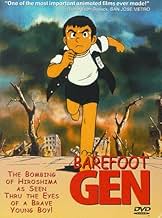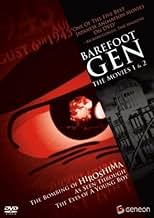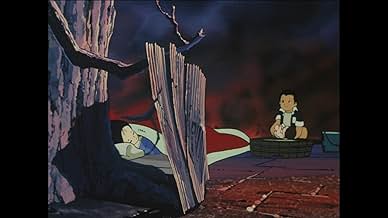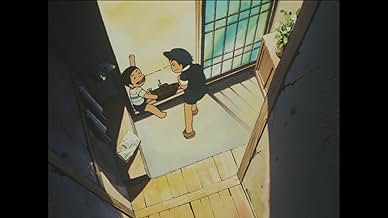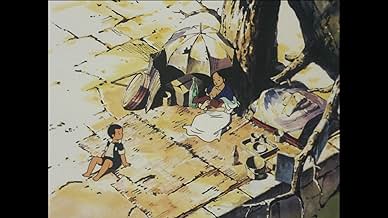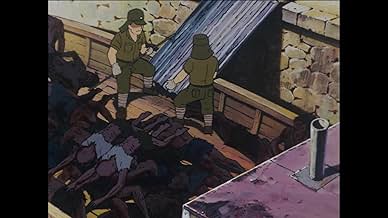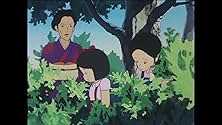Barefoot Gen ist ein kraftvolles Statement gegen den Krieg und eine verstörende Geschichte über die Auswirkungen der Atombombe auf das Leben eines Jungen und das Leben des japanischen Volkes... Alles lesenBarefoot Gen ist ein kraftvolles Statement gegen den Krieg und eine verstörende Geschichte über die Auswirkungen der Atombombe auf das Leben eines Jungen und das Leben des japanischen Volkes.Barefoot Gen ist ein kraftvolles Statement gegen den Krieg und eine verstörende Geschichte über die Auswirkungen der Atombombe auf das Leben eines Jungen und das Leben des japanischen Volkes.
- Auszeichnungen
- 1 wins total
- Gen
- (Synchronisation)
- Gen (1995)
- (English version)
- (Synchronisation)
- Kimie
- (Synchronisation)
- Kimie (1995)
- (English version)
- (Synchronisation)
- Shinji
- (Synchronisation)
- …
- Shinji (1995)
- (English version)
- (Synchronisation)
- (as Brianne Siddal)
- Ryuta (1995)
- (English version)
- (Synchronisation)
- Daikichi
- (Synchronisation)
- Daikichi (1995)
- (English version)
- (Synchronisation)
- (as Kurk Thornton)
- Eiko
- (Synchronisation)
- Eiko (1995)
- (English version)
- (Synchronisation)
- Eizo
- (Synchronisation)
- Eizo
- (English version)
- (Synchronisation)
- (as Amike McConnohie)
- …
- Seiji
- (Synchronisation)
- Hana
- (Synchronisation)
- Pak
- (Synchronisation)
- Pak
- (English version)
- (Synchronisation)
- …
Empfohlene Bewertungen
The film is adapted as an anime from Keiji's short manga series depicting all that he experienced just at the age of six when the bombings hit. His story truly is one of the most amazing things you will ever hear. Nothing else in film has ever captured the effects of the bombings in such a real and emotional way. It shows the viewers what really did happen and what we were never told. It shows us how real the bombings really were as we follow Gen through his struggle for survival during Japan's darkest hours.
If you haven't seen this film, you are missing out. While the film does not hold back on the gritty details, and what happens to the people of Japan throughout the whole of the film is very horrifying, you cannot miss this film due to these aspects. It's these things that make it so real and it would be a tragedy to ignore this film. It opened my eyes to what really went down in Hiroshima and I almost felt personally affected. During my whole time watching this film, I kept finding myself in disbelief that something like this actually occurred in our history, and recently at that. I mean, a whole society was rebuilt on the effects of the bombings and once again shows us how very, very wrong war is. One of the best films I have ever seen.
9.5/10 Hamish Kearvell A.K.A Screaming Japan Productions - www.myspace.com/screamingjapanproductions
Barefoot Gen, the animated version of the autobiographical manga by Keiji Nakazawa, is an unflinching first-hand look at the result of dropping an atomic bomb on a civilian target. Comparisons to Grave of the Fireflies will abound, but for me personally Barefoot Gen was the more moving of the two. Though it centers on the effects of the atom bomb, the fact is this could be about any war, and any people. It is a story for all of humanity.
Barefoot Gen is filled with its fair share of caricatured mannerisms, but calling it a dramedy is pushing it. There isn't much to laugh at and even when the characters act a little over-the-top, the overall effect hits its mark (strongly). What makes the story even more powerful is knowing it comes from a survivor of the attack, and the honesty with which the film doles out darker and darker shades of life in the aftermath of the bombing (including subtle things one might not think about).
I think this along with Grave of the Fireflies belongs in every collection, even if you will only watch it once or twice, if only to show it to future generations. Its one thing to see a big explosion relating to the a-bomb in almost every other anime, but its another thing entirely to see the reality of it, and its aftermath.
At the risk of sounding incredibly pretentious, it made me want to burn flags. Not just from one country, but from all countries... to put it another way, I wish we could be united by our common humanity.
I found this movie informative but disturbing. I have heard it being described as a tragicomedy. I think this is a fitting description but just be prepared because it really does make giant leaps from the genuinely tragic and sad to light heartedness. You won't know whether to laugh or cry. Actually, you will. A little cry would be totally justified so have a hanky at the ready and don't watch it with your mates from down the pub.
Wusstest du schon
- WissenswertesThe author of the "Barefoot Gen" manga, Keiji Nakazawa, said that 70% of the story is based on true events from his experience of the atomic bombing of Hiroshima.
- PatzerWhen Gen and Shinji take a big bite from a sweet potato from each end, they are then told by Eiko to give the sweet potato to their mother. Once the sweet potato is given to her, it is whole again.
- Zitate
Daikichi Nakaoka: This war can't be right. But it's only the cowards like me who dare say it. If there were only a few more like us. You know, sometimes it takes more courage not to fight than to fight, to not want to kill when all around you are calling out for blood. That's real courage in my book. If you boys remember nothing else I teach you, I hope you'll remember that.
- Crazy CreditsThe closing credits run horizontally from the left side. Above the credits is footage of a paper boat lantern built sailing past multiple lanterns. After the boat has slowly vanished, the lanterns slowly turn into stars.
- Alternative VersionenThere's a slightly different version of the movie on the website Rumble. Only one change has been applied to it which is the cut to the scene where Kimie (Gen's mom) finds a dead woman on the forest.
- VerbindungenFeatured in Barfuß durch Hiroshima 2 (1986)
Top-Auswahl
- How long is Barefoot Gen?Powered by Alexa
Details
- Erscheinungsdatum
- Herkunftsland
- Sprache
- Auch bekannt als
- Barfuss durch Hiroshima
- Produktionsfirmen
- Weitere beteiligte Unternehmen bei IMDbPro anzeigen
Zu dieser Seite beitragen


